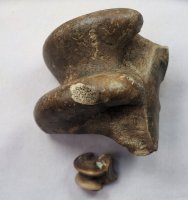Mesohippus sp & Equus sp
Class Mammalia,
Order Artiodactyla, Family Equidae
Geologic
Times: Late Eocene (~35 mya) and Equus: Early Pleistocene (~1.5
mya)
Size (25.4
mm = 1 inch): Mesohippuis:130 mm overall without astragalus (25 mm)
Equus: 290 mm overall without astragalus (65 mm)
Fossil Site:
Mesohippus: Arner Ranch, White River Badlands, Sioux County, Nebraska
Equus: (limb bone) Venice Beach, Sarasota County, Florida; (astragalus)
Leisey Shell Pit, Hillsborough County, Florida
Code: FGF02
Price: Sold
 Description:
These examples of members of the Equidae are separated by some
2500 miles in space and 33+ million years in time. They very well
demonstrate Cope’s Rule which says over time a lineage tends
to increase in size. While Cope himself never made the statement,
it has been Description:
These examples of members of the Equidae are separated by some
2500 miles in space and 33+ million years in time. They very well
demonstrate Cope’s Rule which says over time a lineage tends
to increase in size. While Cope himself never made the statement,
it has been attributed to him, often extended as the Cope-Deperet
Rule, including the person who was a devotee of Cope. The complete
central portion of the foot from the toe upward is preserved for
the Mesohippus, a species that also still had two other smaller
toes flanking the central one. The lower bones have been articulated
and glued together. Also included is the astragalus or “ankle
bone”. The Equus specimen includes the corresponding two
upper bones which can be seen to be far larger in conformance with
Cope’s Rule. While the rule does not hold true in all cases,
it is useful in demonstrating here how the lineage of horses changed
over time. attributed to him, often extended as the Cope-Deperet
Rule, including the person who was a devotee of Cope. The complete
central portion of the foot from the toe upward is preserved for
the Mesohippus, a species that also still had two other smaller
toes flanking the central one. The lower bones have been articulated
and glued together. Also included is the astragalus or “ankle
bone”. The Equus specimen includes the corresponding two
upper bones which can be seen to be far larger in conformance with
Cope’s Rule. While the rule does not hold true in all cases,
it is useful in demonstrating here how the lineage of horses changed
over time. |
|







